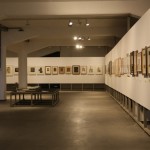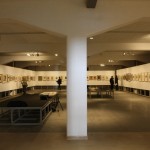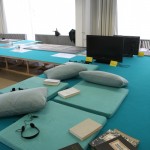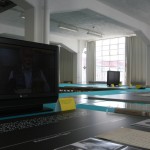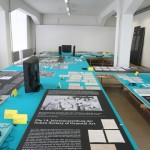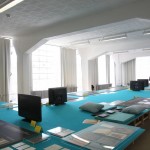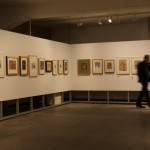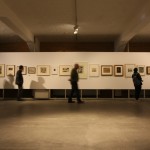Bauhaus Dessau: Bauhaus in Calcutta. A Meeting of the Cosmopolitan Avant-garde
Following on from the 2011 exhibition “Kibbutz and Bauhaus“, the Stiftung Bauhaus Dessau is currently presenting a further exhibition devoted to the global reach of Bauhaus.
Or perhaps better put, a further exhibition devoted to exploring the extent of the global network to which Bauhaus and its students belonged.
This time the journey goes to India.
And whereas “Kibbutz and Bauhaus” was largely concerned with architecture and urban planning, “Bauhaus in Calcutta” is pure art.
In 1922 the Indian Society of Oriental Art staged an exhibition which presented works by Bauhaus artists such as Paul Klee, Lyonel Feininger and Johannes Itten alongside pieces by leading figures in the Indian avant-garde movement including Shanta Devi, Nandalal Bose and Gaganendranath Tagore.
As much as an art exhibition the 1922 show was also a dialogue between two emerging avant-garde movements; two emerging avant-garde movements which although with very different backgrounds and motivations were linked by numerous common principles.
Consequently, although Bauhaus in Calcutta does present ca. 160 works of art it is much more about the background to the Calcutta exhibition than the exhibition itself.
Bauhaus in Calcutta opens by explaining the origins of the Indian art movements associated with the Indian Society of Art and the Bengal School, before moving on to explore the role played by what the curators refer to as the “World Cities” – Berlin, London, Vienna and Calcutta – in propagating the intellectual and cultural networks that enabled such an exhibition to be staged in addition to looking at similarities and differences between the situations in Germany and India in the early part of the 20th century.
Having explained the background, the exhibition moves on to present works by selected Indian and “Bauhaus” artists; although – and in contrast to what we initially thought – not all of the works on display in Dessau were shown in Calcutta.
Rather the exhibition is a “representative reconstruction” of the 1922 exhibition: that is some original works that were shown in India, some “reference pieces” by artists who were presented and reproductions of works from the original exhibition.
Although it would obviously be nice to have had solely works from 1922 on display, given the 90 years that have passed since the Calcutta exhibition and the relatively poor level of original documentation it is to be expected that the curators couldn’t find and/or borrow the original works.
As such their “representative reconstruction” is a perfectly valid alternative and provides a wonderful illustration of what exhibition visitors in 1922 would have experienced. Or at least we trust it does….
What Bauhaus in Calcutta doesn’t do is reflect in any great depth on the long-term consequences of the 1922 exhibition and in particular in how far the Indian art community was influenced by exposure the German guests.
Or vice versa.
However, given the 90 years that have passed since the Calcutta exhibition and the relatively poor level of original documentation…
India, or perhaps better put the Indian sub-continent, did of course, eventually, get to grips with the consequences of Bauhaus: Le Corbusier and Louis Kahn being two of the most prominent modernists to leave their mark on the region, but also in 1958 Charles and Ray Eames wrote their “India Report” for the Indian Government which ultimately led to the establishment of the Indian National Institute of Design.
In how far these later developments can be linked to the contacts and experiences made in 1922, is still open to debate.
And in our opinion, a nice idea for a follow-up exhibition.
“Bauhaus in Calcutta. A Meeting of the Cosmopolitan Avant-garde” can be viewed at the Bauhaus Stiftung Dessau until June 30th 2013.
In addition to the exhibition there is also an extensive accompanying programme of talks, concerts and workshops.
Full details can be found at: www.bauhaus-dessau.de
- Bauhaus Dessau: Bauhaus in Calcutta. A Meeting of the Cosmopolitan Avant-garde
- Bauhaus Dessau: Bauhaus in Calcutta. A Meeting of the Cosmopolitan Avant-garde
- Bauhaus Dessau: Bauhaus in Calcutta. A Meeting of the Cosmopolitan Avant-garde
- Bauhaus Dessau: Bauhaus in Calcutta. A Meeting of the Cosmopolitan Avant-garde
- Bauhaus Dessau: Bauhaus in Calcutta. A Meeting of the Cosmopolitan Avant-garde
- Bauhaus Dessau: Bauhaus in Calcutta. A Meeting of the Cosmopolitan Avant-garde
- Bauhaus Dessau: Bauhaus in Calcutta. A Meeting of the Cosmopolitan Avant-garde
- Bauhaus Dessau: Bauhaus in Calcutta. A Meeting of the Cosmopolitan Avant-garde
